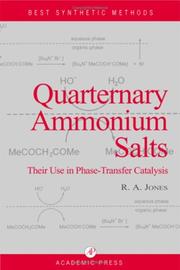| Listing 1 - 4 of 4 |
Sort by
|

ISBN: 9780123891716 012389171X 9780080540153 0080540155 128102595X 9786611025953 Year: 2001 Publisher: San Diego : Academic Press,
Abstract | Keywords | Export | Availability | Bookmark
 Loading...
Loading...Choose an application
- Reference Manager
- EndNote
- RefWorks (Direct export to RefWorks)
This text provides experimental methods for a wide range of organic reactions, systematically arranged according to reaction type, and describes the advantages and limitations of the procedures. Traditional methods to speed up organic reactions involve energy-consuming processes and costly and environmentally ""unfriendly"" solvents. Additionally, isolation of the product requires energy and time-consuming purification processes. A simple solution, especially for reactions involving anionic reactants, is the use of phase-transfer catalysis. Quaternary ammonium cations have the ability to tr

ISBN: 9780123891716 012389171X 9780080540153 0080540155 9786611025953 128102595X Year: 2001 Publisher: San Diego : Academic Press,
Abstract | Keywords | Export | Availability | Bookmark
 Loading...
Loading...Choose an application
- Reference Manager
- EndNote
- RefWorks (Direct export to RefWorks)
This text provides experimental methods for a wide range of organic reactions, systematically arranged according to reaction type, and describes the advantages and limitations of the procedures. Traditional methods to speed up organic reactions involve energy-consuming processes and costly and environmentally ""unfriendly"" solvents. Additionally, isolation of the product requires energy and time-consuming purification processes. A simple solution, especially for reactions involving anionic reactants, is the use of phase-transfer catalysis. Quaternary ammonium cations have the ability to tr
Quaternary ammonium salts. --- Phase-transfer catalysis. --- PTC --- Catalysis --- Ammonium salts
Book
Year: 2008 Publisher: Aberdeen Proving Ground, MD : Army Research Laboratory,
Abstract | Keywords | Export | Availability | Bookmark
 Loading...
Loading...Choose an application
- Reference Manager
- EndNote
- RefWorks (Direct export to RefWorks)
Anti-infective agents --- Charge density waves. --- Quaternary ammonium salts --- Effectiveness. --- Density.
Book
ISBN: 3039284576 3039284568 Year: 2020 Publisher: MDPI - Multidisciplinary Digital Publishing Institute
Abstract | Keywords | Export | Availability | Bookmark
 Loading...
Loading...Choose an application
- Reference Manager
- EndNote
- RefWorks (Direct export to RefWorks)
The rapid increase in the emergence of antibiotic-resistant bacterial strains, combined with a dwindling rate of discovery of novel antibiotic molecules, has created an alarming issue worldwide. Although the occurrence of resistance in microbes is a natural process, the overuse of antibiotics is known to increase the rate of resistance evolution. Under antibiotic treatment, susceptible bacteria inevitably die, while resistant microorganisms proliferate under reduced competition. Therefore, the out-of-control use of antibiotics eliminates drug-susceptible species that would naturally limit the expansion of resistant species. In addition, the ability of many microbial species to grow as a biofilm has further complicated the treatment of infections with conventional antibiotics. A number of corrective measures are currently being explored to reverse or slow antibiotic resistance evolution, Among which one of the most promising solutions is the development of polymer-based antimicrobial compounds. In this Special Issue, different polymer systems able to prevent or treat biofilm formation, including cationic polymers, antibacterial peptide-mimetic polymers, polymers or composites able to load and release bioactive molecules, and antifouling polymers able to repel microbes by physical or chemical mechanisms are reported. Their applications in the design and fabrication of medical devices, in food packaging, and as drug carriers is investigated.
imidization --- antifouling materials --- n/a --- UV-induced polymerization --- 2-hydroxyethyl methacrylate --- additive manufacturing --- antimicrobial resistance --- biofilm --- antibacterial peptides --- ocular infections --- food shelf-life --- hemolytic activity --- polyamide 11 --- coatings from nanoparticles --- polymeric surfaces --- microbial biofilm --- ?-chymotrypsin --- antimicrobial properties --- linear low-density polyethylene --- drug delivery systems --- ESKAPE pathogens --- halictine --- composites --- foodborne pathogens --- layered double hydroxides --- cuprous oxide nanoparticles --- multifunctional hybrid systems --- microbicidal coatings --- adhesives --- acrylates --- quaternization --- polymeric biocide --- biocompatible polymer --- surface functionalization --- sol-gel preparation --- antifouling --- antimicrobial peptides --- polymerizable quaternary ammonium salts --- antibiofilm activity --- polymeric films --- antibacterial activity --- bionanocomposites --- cationic polymers --- Escherichia coli --- antibacterial --- biofilm methods --- drug delivery --- circular dichroism --- coatings wettability --- antimicrobial polymers --- fluorescence --- Staphylococcus aureus --- biofilm analysis --- polyethylene glycol --- copolymerization --- dynamic light scattering --- physiological salt --- copper paint --- medical device-related infections --- olive mill wastewater --- Acinetobacter baumannii --- anti-biofilm surface --- additives --- periodontitis --- periodontal biofilms --- antimicrobial peptide --- segmented polyurethanes --- plastic materials --- biocompatible systems --- bactericidal coatings --- bacteria viability --- wound dressings --- ordered mesoporous silica --- quaternary ammonium --- multidrug-resistant --- antimicrobial polymer --- biofilm devices --- biofilm on contact lenses --- water disinfection --- amorphous materials --- polymers --- infrared spectroscopy --- quaternary ammonium salts --- lipopeptides --- antibacterial properties --- thermal stability --- proteinase --- active packaging --- antibacterial polymers --- anti-biofilm surfaces --- 3D printing --- drug carrier --- persister cells
| Listing 1 - 4 of 4 |
Sort by
|

 Search
Search Feedback
Feedback About UniCat
About UniCat  Help
Help News
News